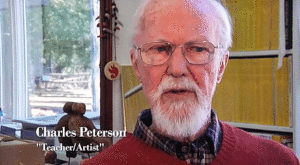An article from the Door County Almanak, No. 1, 1982-83

Chick Peterson
Charles (Chick) Peterson is well-known throughout Door County and the Midwest for his watercolor paintings. His ability as a watercolorist is exceptional, as is his use of an unusually wide variety of subjects. While Chick enjoys painting all kinds of subjects, he says, “I find the excitement of the sea and ships in action particularly appealing.” Marine subjects comprise a large percentage of his works. Likewise, more of his commissioned work has to do with ships than any other single subject.
In choosing a subject, Chick is primarily concerned with the activities of people, using the subject more or less as a pretext for figures in action. In this way, Chick cannot be considered a “typical” marine painter because most of the ships in his work serve as a background for people. While the greater bulk of the history of art in some way includes human life, marine painters for the most part almost never include people. When they do, the figure is very tiny. Even ships are most often depicted very far in the distance, remote from the viewer. The people, and even the ships themselves, historically, are subordinate to the power of nature.
Chick describes his interest in ships this way, “I am fascinated by the human reaction to the sea, as opposed to the beauty or vastness of it. I am more concerned with trying to convey the adventurous element of men in ships, the power the sea holds over men. I am awed by the mastery and power of sailors who handled 150-foot schooners in 40-knot winds totally under sail power.” He has, therefore, “almost never” painted a seascape without including human activity.
One of the ways the artist conveys this sense of adventure and power is to paint the ship as though he, and thus, the viewer, were on board the ship. He projects the image to give the viewer the sense of actually being on board a real ship in action. One of his paintings, for example, was done from the perspective of being at the wheel looking forward as the schooner was about to change her heading. The captain was shouting to the crew to “Stand by!” The crew was looking back, as though at the viewer.
Another device Chick has used with many different subjects is a translucent image of “specter.” It is a visible image which suggests an idea of what most of us would create in our minds when Viewing something old. Seeing an old ship, for example, would often cause us to wonder what the sailors looked like or what life in those times was like… The artist explains, “The device has been used by artists for centuries as a way of reminding the viewer of the human connection. I have used it myself in various ways for 25 years, but my use of the device in water is more recent and more foolhardy… because the medium (of watercolor) imposes severe technical restrictions.”
Chick’s interest in ships goes beyond the human challenge and excitement of the sea; he finds other challenges in painting them as well. He began drawing ships as a child and started sailing in high school. The sport has since become his major recreational interest. He was in the Navy during World War II, an experience which enhanced his interest and exposure to ships.
After his marriage to his wife, Sue, and while still an art and art history professor at Marietta College in Ohio, the artist began spending summers in Ephraim where his wife’s parents kept a boat at Anderson Dock. During these summer visits, Chick managed to sell enough paintings to buy a small sailboat which they named “Aquarelle,” both because the name means “water” and because it was paid for by selling watercolors. This increased exposure to sailing and sailboats in Door County, along with a personal lifelong interest in history, led Chick easily into historical ships by the time he and Sue decided to settle permanently in Door County. While most of the ships he paints are historical Great Lake ships, he has done commission works, such as a barge, launched last year to Bay Shipbuilding Corp., in Sturgeon Bay. For the most part though, the artist enjoys the romance of historical ships – sailing ships especially – and older steam vessels, stern wheelers, etc.
The details of the ships he paints are always exact. The ship proportions are made according to actual measurements of the real ship, the sails always set correctly. (His own small library includes books by Chapelle, a naval sailing historian whose books include blueprints which enable Chick to get actual measurements projected by perspective. He also regularly does research at the Manitowoc Maritime Museum.)
For a realistic painter like Chick, there is a challenge in figuring out the actual technicalities of sailing involved in painting. He explains, “A work often involves research to discern, for example, how a schooner would lie to, as opposed to a square-rigged ship. It is important to recognize though, that such aspects are side interests and never the reason for the painting. While enjoyable and satisfying to a more or less logical mind like my own, they are nevertheless subordinate to the design of the painting: “The design of the paint is most important.”
People have often thought that it must be monotonous to do paintings of schooners (he has done 50 or 60 of them.) Just the opposite is true. Chick finds a new challenge in every painting he does. He has, for example, painted Anderson Dock in Ephraim over 200 times, but each time finds it a new challenge. He explains, “ Because the light changes, the wind conditions change, the set of the sails change… every painting becomes its own new problem. I learn something new form each one. Even because water itself is endlessly varying. I find it necessary to practically reinvent a pattern of colors to represent water in each work I do. There seems to be no end of the possibilities. The same is true of figures… If there was enough technical challenge in painting hundreds of haystacks to intrigue a man like Money, I guess there is enough in ships for me.”
The artist works in his Ephraim studio every day – often including weekends – from about 9 a.m. until the light fails, producing an average of two paintings per week over a year’s time. He paints because he must. He paints because painting is satisfying. He paints because he finds painting “an exasperating challenge… (I) never achieve what (I) imagined (I) would.”
If the outstanding works this artist produces now are not what he imagined, I expect we will be seeing some incredible paintings form Chick in the years to come.

Chick Peterson
Watch a video interview from 2012 here: https://www.youtube.com/watch?v=kTKikL_my8I


